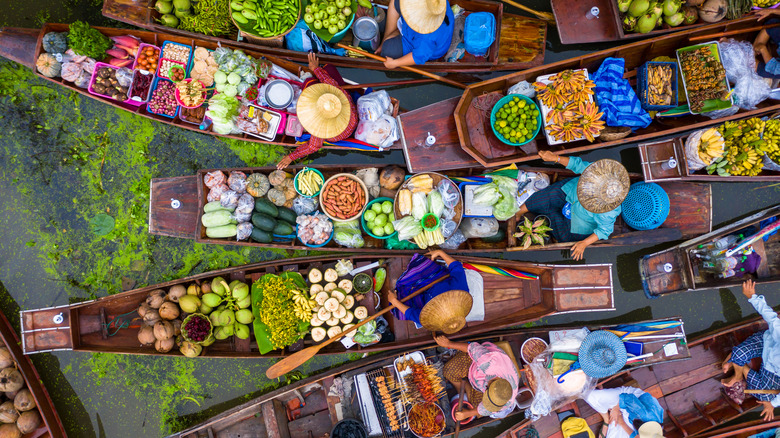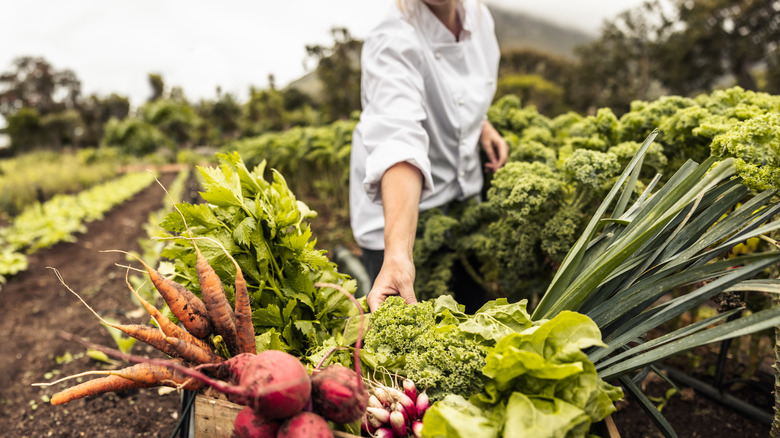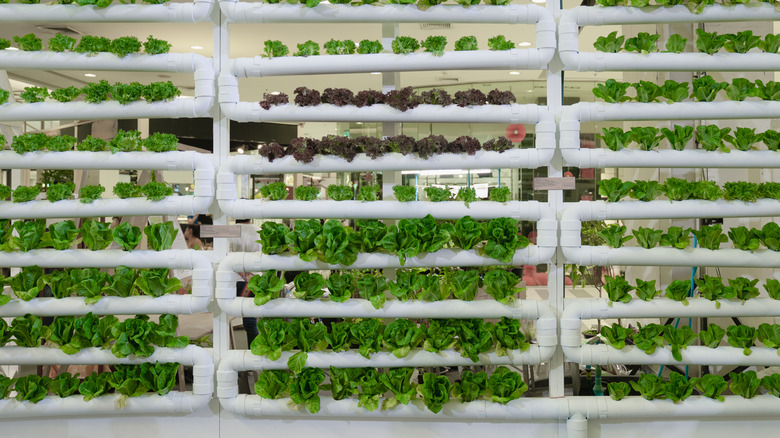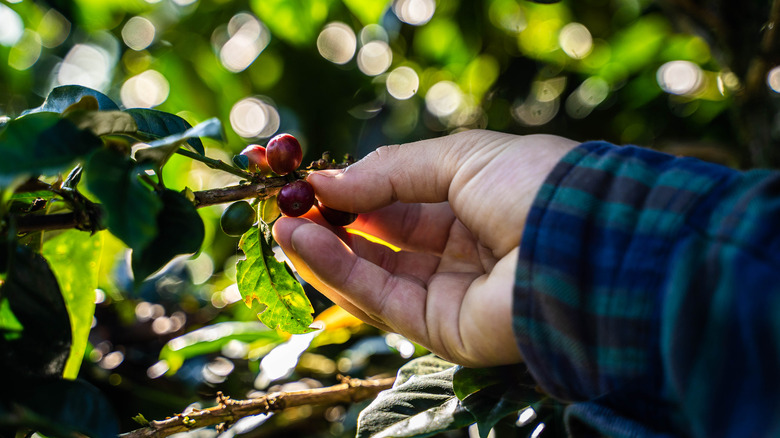The Foodie Travel Trends That Are Stealing The Spotlight In 2023
The years surrounding the pandemic have fundamentally changed the way we eat and travel. After all, with more time at home and increased existential stress, who hasn't turned to food for comfort, creativity, and resilience? While we couldn't travel physically, we instead traveled with our mouths and plates.
Now, as the world opens up, yet changes all the more, we find ourselves able to travel again. It seems that the way we eat when traveling is shifting too, despite us being in place for so long. While 2023 may be full of mystery, hope, and worry, no matter what happens and changes in life, people will continue to best enjoy the travel destination by eating a bit of it. In all the insecurity and uncertainty of the times, it does remain clear that wherever we go, there we eat! Below, are 12 foodie travel trends that are sure to take you away in 2023, just as much as they will fill you up!
Train dining
Train dining probably isn't what comes to mind when traveling in the U.S. But, given the different variants and travel restrictions, it can be much easier (and safer) to keep kicking it stateside. According to The Christian Science Monitor, though train travel hasn't been the most preferred, or feasible, mode of travel for most Americans, it seems like in the wake of the pandemic it's gaining traction. After all, train travel doesn't require fueling up or constant attention like a road trip, and hasn't been affected by heavy staff shortages like airport travel. It's pretty comfortable, and it's a good way to leisurely enjoy the journey as well as the destination.
It makes sense that with all the time spent on board, eating would be something to take into consideration when on the rails. Luckily, Amtrak offers up full-blown restaurant carriages with anything from coffee to complete meals to satiate the stomach. Similar to airline food, train food is usually not the star of the show, but rather a practical necessity. However, there are train lines that focus solely on the culinary experience and provide for a more grand and gourmet foodie experience for travelers. The Kentucky Dinner Train, for example, offers a pairing of the state's finest liquor with luxury meals in the fantastically named Bourbon Excursion. Hop aboard the Tennessee Valley Rail Road's dinner train, which departs from Chattanooga's Grand Junction, and enjoy a three-course meal in a restored dining car while enjoying the scenery.
Immersive culinary travel
It doesn't matter where in the world you go, your tummy's going to be rumbling! We simply have a need to feed. So, it may seem simple to bring up culinary travel as a 2023 travel foodie trend. Isn't all travel foodie travel?
It's not quite that cut and dry. Thirsty magazine defines immersive culinary travel as a sort of food tourism. It argues that food works as a shared culture. We all need to eat, and it's this need that connects us. All the while, each culture has its own unique history, geography, and produce that makes for one-of-a-kind cuisine.
So, while traveling and eating can be understood as food tourism, immersive culinary travel works with a bit more intention. Travelers must actively seek out food that's special to the region and culture. This needn't only be fancy restaurants, but could also be any way of enjoying food as the locals do. Joining a walking food tour is a great way to sample the area's dishes.
Interestingly, the European Interrail train service offers immersive food services for those traveling the European continent. These packages are as varied as the Eurorail's destinations and include activities such as making quiche in France, relaxing with an English brunch, or trying freshly-caught seafood in Portugal. While sightseeing is a wonderful way to engage with a country, we can learn, and experience, just as much when digging in.
Zero-kilometer eating
Zero-kilometer eating takes eating local to the next level, or rather to the closest mile. As defined by the French collective Initiative et Développment Citoyen, or IDC, zero-kilometer food is any product, or produce, that travels less than 100 kilometers or 62 miles. But, what can we say, 62-mile food just doesn't have the same ring to it that zero-kilometer does!
This idea may sound very close to the farm-to-table movement, which was popularized by California-based chef Alice Waters. There are some minute differences though; for one, the focus remains on the entire food ecosystem and not just the farm. While farm-to-table has to do with the farm providing produce and products to the specific restaurant, zero-kilometer eating is more so a community approach where each and every ingredient comes from within a relatively small radius. Of course, this is beneficial not only for the local economy but also farmers and foodways.
Interestingly, when traveling in the U.S., there's an added benefit to the zero-kilometer eating in that the supply chain is less likely to be disturbed. When traveling abroad, you may be surprised by how non-revolutionary zero-kilometer food is. Italy, for example, has a cuisine that heavily focuses on hyper-unique cuisine that utilizes all the goodness that's within grasp (via Livitaly). When entering the New Year, it's certainly nice to reflect on better ways to use what's on hand, both at home and abroad.
Street food
Street food has been around forever, and in most cities around the world, you can find at least a dozen winners on every block! According to the folks over at Guilty Eats, the history of food on the street really goes back much further than contemporary times. In Europe at least, it's theorized that street food dates back to Ancient Greece! The same source also notes that Ancient Romans are said to have snacked on street fish too, as ovens and hearths were rare to have in the kitchen during that time.
It's a credit to street food, and to society's relationship with it, that they've stuck around as long as they have. V Street Food credits this longevity to the transient nature of the dining style: it's low-key, laid-back, and open to variability. Simply said, street food can be just about anything you want it to be!
Guilty Eats also posits that opting for some quick eats while on the road not only brings you into contact with the locals at a low cost but also lets you enjoy the city in an off-the-beaten road type of way. Many believe that street food vendors will continue to opt for more fresh and organic ingredients and the low-cost to-high-quality ratio will help this dining style to continue to grow in popularity over 2023.
All-inclusive resorts
All-inclusive resorts have been written off for a while as boring, unnecessary, and perhaps, worst of all, touristy. But, there has been renewed interest in them as of late, and this could be because of one show in particular, "White Lotus." The characters lavish in nearly empty and massive resorts, where they quirkily wade through what can only be described as compelling dysfunction. The popularity of the show seems to have done something for travel-hungry watchers who now want to experience a little bit of the magic.
An article from The Guardian observes that the Four Seasons featured in season 1 has seen an absolute upswing in bookings as the season aired to a pitch that nearly matched pre-pandemic levels. But, the resort-centered dramedy has one more quirk worth noting. As one Twitter user points out: The characters only eat from the hotel! This is pretty astonishing given that one season was set in Hawai'i and the other in Italy. For the less adventurous eaters, the all-inclusivity of the resorts may not be a drawback. As Hotel News Resource notes, convenience has become a large factor for the modern patron. Being able to enjoy the sun while sipping on a cocktail and the food provided through accommodation, is the perfect option for some visitors who just want to sit back and relax.
Vertical farming
Who knows, maybe one day zero-kilometer food will really be zero kilometers! Vertical farming seriously makes the case for it at least. According to Berlin's IFA, these vertical farms are nothing short of what they call a "megatrend." These little farms are small greenhouses that are stacked on top of each other to make for a cubical farm. As compared to other greenhouse forms, these are intended to be constructed inside. This is pretty stellar, considering the vertical garden may one day become a part of the kitchen!
For right now though, it seems like at least some restaurants are bringing gardens and farms into their design. In Italy, chefs sought to create fresh salads for hospital workers who were toiling day-in and day-out according to Vertical Farm Daily. These fresh salads eventually snowballed into a full-blown restaurant concept that centered around an indoor farm, from which the restaurant could source all of its salads. When visiting Italy and diving into zero-kilometer food, it doesn't get any closer than that. Keep your eyes peeled when traveling domestically as well, perhaps vertical farm-oriented restaurants will be found in every city in only a matter of time.
Zero-proof cocktails
Sources at The Atlantic and BBC report that both Millennials and Gen Z are showing stronger tendencies towards sobriety than previous generations. Both articles point out the generations are approaching alcohol with less fervor, and often opt to drink far less, if at all.
It may come as no surprise then, that zero-proof cocktails are coming into trend right now. In a 2021 Nielson study, it was found that the sale of non-alcoholic cocktails increased by 33% over the year and the sale of low-ABV and zero-proof beverages increased by a whopping 315%.
Mocktails are typically made with a more sugary mix of juices, while hootch-free cocktails attempt to strike the trademark sophistication for which classic cocktails are praised. This can involve a mix of sparkling waters, herbs, syrups, and fizzes to make a complex flavor that feels absolutely decadent to sip on. When you want to try all the drinks while traveling and still wake up energized in the morning, a zero-proof cocktail is your best bet. They're becoming increasingly popular in major cities as bars are popping up from San Francisco to Germany that are putting unique local spins on the beverages. Minneapolis is even getting a name for its selection of bevies for bon vivant who don't want to get boozy.
Vegan-focused vacations
Veganism has become more and more a part of the American diet. In fact, it's grown so much in popularity that The Guardian described veganism as a part of mainstream American cuisine. This is pretty impressive given how it was considered to be on the fringe just five years ago.
In days gone by, vegetarians, much less vegans, would have to seriously work to find suitable dietary accommodations while on the road. But, the world of lackluster salads and oodles of french fries while traveling is a thing of the past as vegan vacations are coming into vogue, according to Shondaland. Vegan holidays don't even have to be a rare or off-the-beaten path type of deal (though they can be!). From luxurious resorts, to calm beaches and bustling cities, more options and vegan foods are coming to the table.
In fact, you can even embark on a seven-night Holistic Holiday at Sea Vegan cruise aboard the MSC Divina out of Miami, Florida. The cruise sails to various ports of call, including Belize, Honduras, Mexico, and the Bahamas, and includes presentations by nutritionists, authors, and leading plant-based physicians, health and wellness classes, and of course, delicious vegan cuisine.
Cannabis cuisine
In the last decade, several states have legalized marijuana for both medicinal and recreational use. The latter of which has brought in a slew of innovations in the gastronomical sphere. There are a lot of reasons why people want to cook with weed, but the major reason is that the psychoactive component in marijuana (THC) can easily be made into cooking oil and butter. When infused with meals, these oils and butters have the same effect as the plant when smoked. Essentially, one can combine the classic combination of smoking and eating into one meal.
Given the possibilities and popularity of THC, it's no surprise that legal marijuana has hit many cities' gastro scenes. In this ever-new and brave world, it's completely possible for intrepid foodie explorers to have a different kind of meal when visiting these cities. For example, New York restaurants have really embraced the plant in a way that only the Big Apple can. In 2022, The New York Times reported that some chefs were even opting to host multi-course dinners that are completely cannabis-infused. This decadent experience is probably not what first comes to mind when thinking of weed-infused meals, but it's certainly one style worth exploring. In some cities, you can even find cannabis food tours that give you a look at the city while you enjoy cannabis-infused treats.
Sustainable eats
Hotel News Resource points out that we are becoming more conscious travelers as a whole. It is not surprising then, that sustainability very well applies just as much to the food world. This push for sustainability is very serious when it comes to traveling, even if food isn't the first thing that comes to mind when thinking of it. After all, Out Look India makes the apt point that food is a crucial part of travel. It helps travelers connect to the region, the people, and the history. Just like all things worthwhile, food and the foodways surrounding it, are worth preserving, conserving, and sustaining.
Ecotourism World makes the argument for gastronomy tourism, and that it can be done in a way that doesn't overwhelm the local foodways. The tourism site notes that it's possible for travelers to fully incorporate the region's diet into their own lifestyle while traveling. This food trend typically focuses on travelers opting for traditional recipes, local produce, and supporting smaller businesses. Beyond that, even participating in the harvesting of crops, taking a cooking class, or getting involved in a food festival has become popular for sustainable foodies on the road.
Food walking tours
It's at the beginning of the year that maybe we feel the most motivated to get moving and grooving. What better way to look forward to warmer weather, and brighter horizons, than scheduling a walking tour? Not only do walking tours let you really see the city first-hand, foodie walking tours let you eat it first-hand too!
Guided food tours are a great way to get into local gems and best-kept secrets without having to spend hours scouring the internet. This is a pretty good time-saver, especially given major cities like New York that have a seemingly endless list of delectable diners. One walking tour even offers a "Sex and the City" food walking tour to let fans of the legendary show brunch just like the gals did. In general, food tours tend to be a little bit more self-regulated and allow for walkers to sit down and stay a little while when digging into local dishes. For the foodie on foot, a culinary walking tour is an absolute must in 2023.











